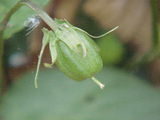570102 Viola canina L.
Distribution
Northern Iceland: Frequent
Northern Fennoscandia: Scattered
Western Greenland: Rare
Shrub Tundra: Scattered
Bordering boreal or alpine areas: Frequent
- L., Sp. Pl.: 935 (1753). Lectotype (LAPP): Sweden: "Lapland". Linnaean Lapland Herbarium 277 (Nikitin 1995: 93).
- Viola montana auct., non L., Sp. Pl.: 935 (1753). - Viola canina subsp. montana sensu Hartm., Bot. Not. 1841: 82 (1841).
- ?Viola nemoralis Kütz., Linnaea 7: 46 (1832). Described from near Regensburg (Germany).
2n=
40+0-10B (8x). - Europe (N, C), Russia (N, C), Siberia (S). - Numerous reports, partly for V. montana.
Not included: Reports of 2n = 20 (4x) from Germany (Lippert and Heubl 1989) and of 2n = 72 (Clausen 1927).
Geography: Amphi-Atlantic (E) - European - Asian (W): ICE NOR RUS GRL.
Notes: Marcussen and Elven: The majority of authors have accepted two parapatric races or species in European floristic surveys - Viola canina and V. montana (V. canina subsp. montana) - the former temperate to boreal, the latter boreal to alpine and southern arctic. The name V. montana most probably belong to another, more southern species (see Excluded taxa). The first species name for the northern plant may be V. nemoralis Kütz., applied by Tzvelev in comments and several publications.
Elven (1994) and Elven et al. (2005) preferred to treat it at best as subspecies but no subspecific combination based on V. nemoralis or any other name (except "montana") is available. Where well separated geographically, the southern and the northern/alpine plants differ in general habit and in, e.g., shape of lamina and shape and size of stipules. However, where they meet - as they do over most parts of Fennoscandia - they can not be consistently kept apart. Nearly all of central and western Fennoscandia may be a transition zone or the variation may be clinal. The choice is between two races or no treatment. Marcussen (2007, 2010) argued that there is no correlated morphological and geographical structure and that "the reasons for maintaining the two subspecies have been other than biological" (Marcussen 2007). He suggested that extensive misidentification of specimens of V. riviniana and V. canina x riviniana has confused the picture.
Higher Taxa
- Viola [5701,genus]
